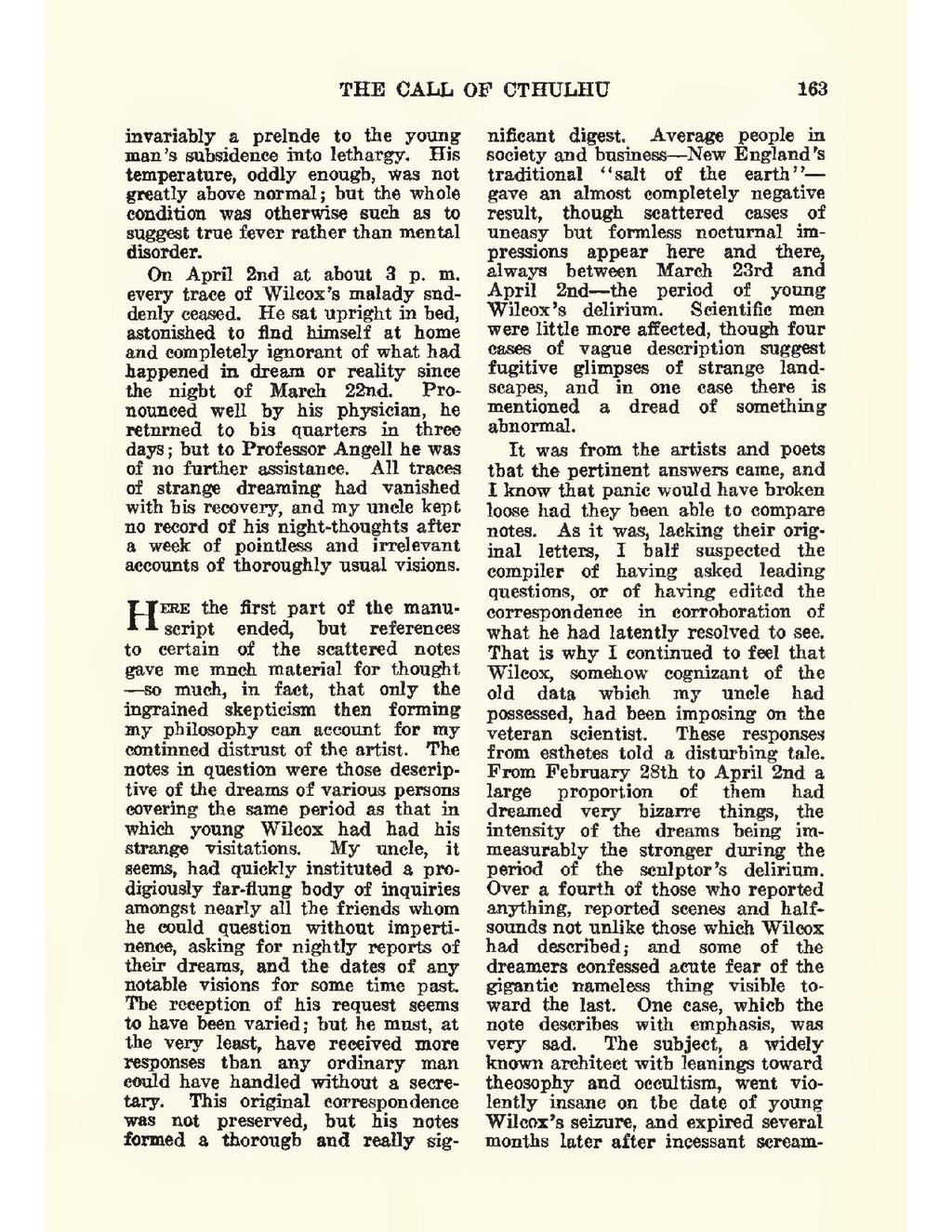invariably a prelude to the young man’s subsidence into lethargy. His temperature, oddly enough, was not greatly above normal; but the whole condition was otherwise such as to suggest true fever rather than mental disorder.
On April 2nd at about 3 p. m. every trace of Wilcox’s malady suddenly ceased. He sat upright in bed, astonished to find himself at home and completely ignorant of what had happened in dream or reality since the night of March 22nd. Pronounced well by his physician, he returned to his quarters in three days; but to Professor Angell he was of no further assistance. All traces of strange dreaming had vanished with his recovery, and my uncle kept no record of his night-thoughts after a week of pointless and irrelevant accounts of thoroughly usual visions.
Here the first part of the manuscript ended, but references to certain of the scattered notes gave me much material for thought—so much, in fact, that only the ingrained skepticism then forming my philosophy can account for my continued distrust of the artist. The notes in question were those descriptive of the dreams of various persons covering the same period as that in which young Wilcox had had his strange visitations. My uncle, it seems, had quickly instituted a prodigiously far-flung body of inquiries amongst nearly all the friends whom he could question without impertinence, asking for nightly reports of their dreams, and the dates of any notable visions for some time past. The reception of his request seems to have been varied; but he must, at the very least, have received more responses than any ordinary man could have handled without a secretary. This original correspondence was not preserved, but his notes formed a thorough and really significant digest. Average people in society and business—New England’s traditional “salt of the earth”—gave an almost completely negative result, though scattered cases of uneasy but formless nocturnal impressions appear here and there, always between March 23rd and April 2nd—the period of young Wilcox’s delirium. Scientific men were little more affected, though four cases of vague description suggest fugitive glimpses of strange landscapes, and in one case there is mentioned a dread of something abnormal.
It was from the artists and poets that the pertinent answers came, and I know that panic would have broken loose had they been able to compare notes. As it was, lacking their original letters, I half suspected the compiler of having asked leading questions, or of having edited the correspondence in corroboration of what he had latently resolved to see. That is why I continued to feel that Wilcox, somehow cognizant of the old data which my uncle had possessed, had been imposing on the veteran scientist. These responses from esthetes told a disturbing tale. From February 28th to April 2nd a large proportion of them had dreamed very bizarre things, the intensity of the dreams being immeasurably the stronger during the period of the sculptor’s delirium. Over a fourth of those who reported anything, reported scenes and half-sounds not unlike those which Wilcox had described; and some of the dreamers confessed acute fear of the gigantic nameless thing visible toward the last. One case, which the note describes with emphasis, was very sad. The subject, a widely known architect with leanings toward theosophy and occultism, went violently insane on the date of young Wilcox’s seizure, and expired several months later after incessant scream-
